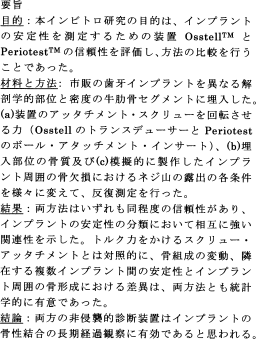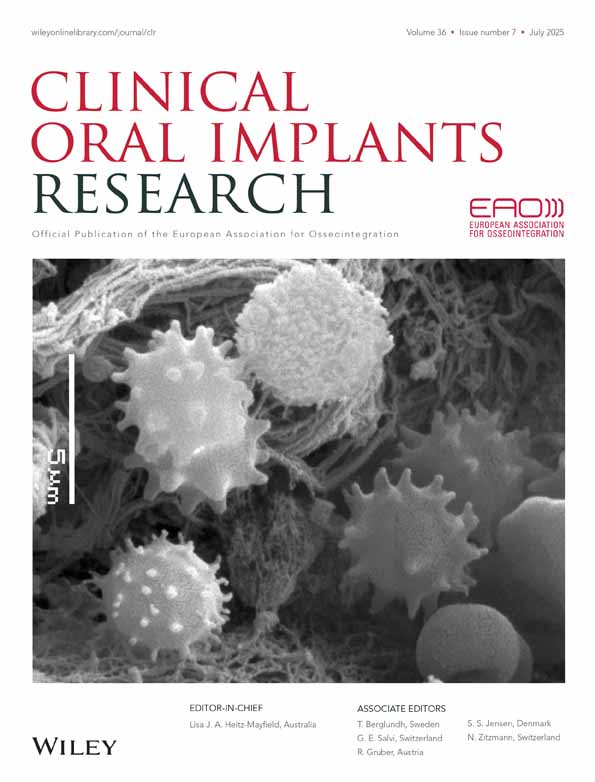Resonance frequency analysis and damping capacity assessment
Resonanzfrequenz-Analyse und Klopfdämpfungsverfahren. Teil 1: in vitro Reliabilitätsuntersuchungen und Methodenvergleich für die Bestimmung der Primärstabilität dentaler Implantate
Part 1: an in vitro study on measurement reliability and a method of comparison in the determination of primary dental implant stability
The authors confirm that the submitted research project is original, not under consideration for presentation elsewhere, free of conflict of interest and conducted under the highest human and subject and animal welfare.
Some results of this study have been presented on the 81st General Session of the IADR in Gothenburg, June 27, 2003, in an oral presentation.
Abstract
enObjectives: The aims of this in vitro study were to evaluate reliability of the Osstell™ and Periotest™ devices in the assessment of implant stability and to perform a method comparison.
Material and methods: Commercial dental implants were inserted into bovine rib segments of different anatomical origins and densities. Repeated measurements were performed, varying (a) the torque-in force of the devices' attachment screw (the Osstell™ transducer and the ball attachment, insert for the Periotest™ device), (b) the insertion site bone quality, and (c) the thread exposure in simulated peri-implant bone defects.
Results: Both methods were comparably reliable and showed a strong association to each other in the classification of implant stability. As opposed to torque-forced screw attachment, the variations in bone composition, differences in inter-implant stability of adjacent implants, and peri-implant bone reduction were statistically significant for both methods.
Conclusions: Both non-invasive diagnostic devices seem to be useful in the long-term follow-up of implant integration.
Résumé
frLes buts de cette étude in vitro ont été d'évaluer la fiabilité des systèmes Osstell™ et Periostest™ dans l'évaluation de la stabilité implantaire et de les comparer. Des implants dentaires ont été insérés dans des segments de côtes bovines de différentes origines anatomiques et de densité. Des mesures répétées ont été effectuées, variant a) le couple de torsion à l'insertion de la vis d'attache (le transducteur Osstell™ et l'attache boule insérée pour le système Periotest™), b) la qualité osseuse du site d'insertion et c) l'exposition du filetage dans des lésions osseuses paraïmplantaires simulées. Les deux méthodes étaient comparativement fiables et ont montré une association importante l'une envers l'autre dans la classifiaction de la stabilité implantaire. Contrairement à la force de torsion de l'attache de la vis, les variations dans la composition osseuse, des différences dans la stabilité interimplantaire d'implants adjacents et la réduction de l'os paraïmplantaire étaient statistiquement significatifs pour les deux méthodes. Les deux systèmes diagnostiques non-invasifs peuvent être utiles dans le suivi à long terme de l'intégration implantaire.
Zusammenfassung
deZiele: Die Ziele dieser Studie waren, die Reliabilität der Resonanzfrequenz-Analyse (Osstell-Gerät) und Klopfdämpfungsverfahren (Periotest-Gerät) bei der Beurteilung der Implantatstabilität zu bestimmen und beide Methoden zu vergleichen.
Material und Methoden: Kommerziell erhältliche dentale Implantate wurden in bovine Rippensegmente unterschiedlicher anatomischer Herkunft und Dichte eingebracht. Wiederholte Messungen der Implantatstabilität wurden durchgeführt unter Änderung (a) der Eindrehstärke der Befestigungsschraube des Messfühlers (Osstell-Transducer) und des Kugelkopf-Attachments (Periotestmessungen), (b) der Knochenqualität am Implantationsort und (c) der Größe des Defektes an freigelegten Implantatabschnitten bei simuliertem periimplantärem Knochenabbau.
Ergebnisse: Die Ergebnisse beider Verfahren waren vergleichbar reliabel und ähnelten sich sehr bei der Beurteilung der Implantatstabilität. Die Fähigkeit, unterschiedliche Knochenqualität, unterschiedliche Primärstabilität benachbarter Implantate und eine progressive Abnahme periimplantärer knöcherner Verankerung zu beurteilen, war bei beiden Methoden statistisch signifikant. Der Einfluß der Eindrehstärke von Transducer-Schraube und Periotest-Meßpfosten hingegen war ohne Bedeutung.
Schlussfolgerungen: Beide nicht-invasiven Untersuchungsmethoden scheinen für eine Langzeitbeurteilung der knöchernen Integration dentaler Implantate geeignet zu sein.
Resumen
esObjetivos: Las intenciones de este estudio in vitro fueron evaluar la fiabilidad de los dispositivos Osstell™ y Periotest™ en la valoración de la estabilidad implantaria y llevar a cabo un método de comparación.
Material y métodos: Se insertaron implantes dentales comerciales en segmentos de costillas bovinas de diferente origen anatómico y densidad. Se llevaron a cabo mediciones repetidas, variando (a) la fuerza de torque de inserción de los dispositivos de tornillo de inserción (el transductor Osstell y la bola de inserción para el dispositivo Periotest), (b) la calidad del lugar óseo de inserción, y (c) la exposición de roscas en los defectos óseos periimplantarios simulados.
Resultados: Ambos métodos fueron comparablemente fiables y mostraron una fuerte asociación el uno al otro en la clasificación de la estabilidad implantaria. En oposición a las inserciones de tornillo forzadas de torque las variaciones en la composición ósea, las diferencias en la estabilidad inter-implante de implantes adyacentes, y la reducción de hueso periimplantario fueron estadísticamente significativas para ambos métodos.
Conclusiones: Ambos dispositivos diagnósticos no invasivos parecen ser útiles en el seguimiento a largo plazo de de la integración de los implantes.





